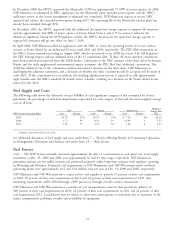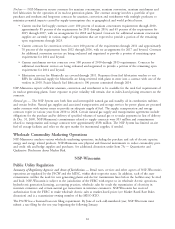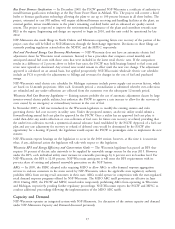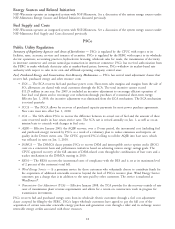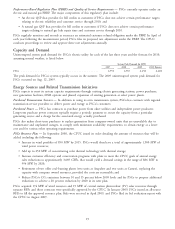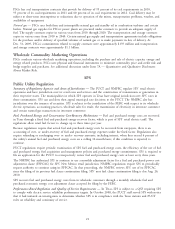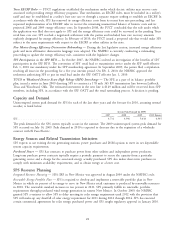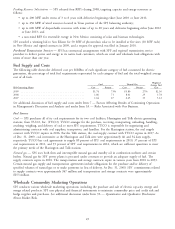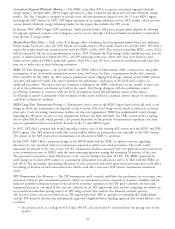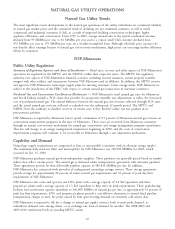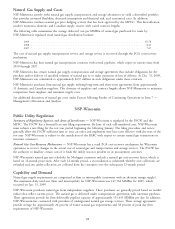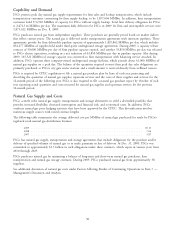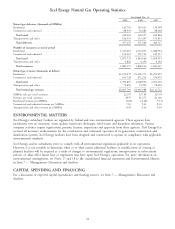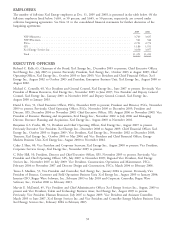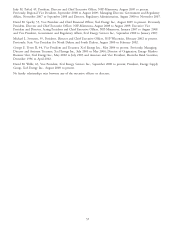Xcel Energy 2009 Annual Report Download - page 35
Download and view the complete annual report
Please find page 35 of the 2009 Xcel Energy annual report below. You can navigate through the pages in the report by either clicking on the pages listed below, or by using the keyword search tool below to find specific information within the annual report.Centralized Regional Wholesale Markets — The FERC rules allow RTOs to operate centralized regional wholesale
energy markets. In April 2005, MISO began operation of a Day 2 regional day-ahead and real time wholesale energy
market. The Day 2 market is designed to provide more efficient generation dispatch over the 15 state MISO region,
including the NSP System. In 2007, SPP began operation of an energy imbalance service (EIS) market, which provides
a more limited wholesale energy balancing market for the region that includes the SPS system.
In January 2009, MISO began ASM operations, which provide further efficiencies in generation dispatch by allowing
for regional regulation response and contingency reserve services through a bid-based market mechanism co-optimized
with the Day 2 energy market.
Market Based Rate Rules — Each of the Xcel Energy utility subsidiaries has been granted market-based rate authority.
Under market based rate rules, the NSP System was reauthorized to sell at market-based rates in June 2009. SPS filed a
request for market-based rate reauthorization with the FERC in July 2009. That request is pending FERC action. PSCo
will be required to file for such reauthorization in June 2010. Presently the Xcel Energy utility subsidiaries may not sell
power at market-based rates within the PSCo and SPS balancing authorities, where they have been found to have
market power under the FERC’s applicable analysis. Both PSCo and SPS have cost-based coordination tariffs that they
may use to make sales in their balancing authorities.
FERC Tie Line Investigation — In October 2007, the FERC Office of Enforcement, DOI, commenced a non-public
investigation of use of network transmission service across the Lamar Tie Line, a transmission facility that connects
PSCo and SPS. In July 2008, the DOI issued a preliminary report alleging Xcel Energy violated certain FERC policies
and rules and approved tariffs. The report represents the preliminary conclusions of the DOI and is subject to
additional procedures. The report does not constitute a finding by the FERC, which may accept, modify or reject any
or all of the preliminary conclusions set forth in the report. Xcel Energy disagrees with the preliminary report.
Xcel Energy continues to cooperate with the DOI investigation. Given the preliminary nature of this matter,
Xcel Energy is unable to determine if the resolution of this matter will have a material adverse impact on operations,
cash flows or financial condition.
MISO Long-Term Transmission Pricing — Transmission service rates in the MISO region have historically used a rate
design in which the transmission cost depends on the location of the load being served, which is referred to as license
plate rates. Costs of existing transmission facilities are thus not regionalized. MISO has implemented several changes
regarding the allocation of costs for new transmission facilities. In 2006 and 2007, the FERC issued orders accepting
the so-called RECB tariff, which provide a 20 percent limitation on the portion of transmission expansion costs that
may be regionalized and recovered from all loads in the 15 state MISO region.
In 2007, AEP filed a proposal that would regionalize certain costs of the existing AEP system over the MISO and PJM
RTO regions. The AEP proposal would shift several million dollars in transmission costs annually to the NSP System.
The impact of the AEP proposal on transmission cost allocation in MISO is uncertain.
In July 2009, MISO filed a proposed change to the RECB tariff with the FERC to address concerns regarding
allocation of costs associated with new transmission required to deliver new wind generation. This tariff would
regionalize 10 percent of the cost of new 345 KV transmission facilities associated with new generation interconnections
across transmission users in MISO, with the interconnecting generator paying the remaining 90 percent of the costs.
The generator is required to fund 100 percent of the costs for facilities less than 345 KV. The FERC approved the
tariff change in October 2009, subject to a permanent replacement cost allocation tariff to be filed with the FERC in
July 2010. The uncertainty surrounding allocation of costs associated with wind generation interconnection could affect
the timing or location of such interconnections, which could affect near term NSP System transmission investment
needs.
SPP Transmission Cost Recovery — The SPP transmission tariff currently establishes the mechanism for recovering costs
associated with base plan transmission projects, which are transmission projects required to maintain reliability, and for
balanced portfolio transmission projects that promote economic expansion of the SPP grid. Currently, for base plan
transmission projects, one-third of the costs are collected on an SPP region-wide basis and the remaining two-thirds are
recovered from individual pricing zone(s) in SPP using a power flow analysis. For balanced portfolio projects,
100 percent of the costs are recovered on an SPP region-wide basis. SPP is currently re-evaluating this methodology,
and the SPP board of directors has preliminarily approved a highway/byway funding approach that would allocate costs
as follows:
• For projects rated at a voltage level less than 100 KV, all costs would be recovered from the pricing zone of the
project;
25


